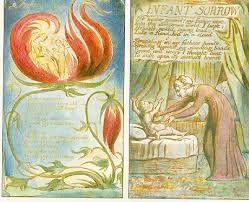 William Blake's triumvirate of collective poems, Songs of Innocence and Experience and The Marriage of Heaven and Hell come together to create the portrait of man and life stages. Throughout each collection, nature is used in different ways to accentuate the images Blake's poems were meant to evoke.
William Blake's triumvirate of collective poems, Songs of Innocence and Experience and The Marriage of Heaven and Hell come together to create the portrait of man and life stages. Throughout each collection, nature is used in different ways to accentuate the images Blake's poems were meant to evoke.
Songs of Innocence and Songs of Experience are two works that are defined by their names. In Songs of Innocence, the reader is taken back to childhood, where everything was a discovery, full of the beauty of nature. The animals in the collection are friendly and it is natural for the narrator to praise them, or even engage in conversation with them, "Pretty, pretty robin/ under leaves so green/ a happy blossom/ hears you sobbing, sobbing," (Greenblatt et al, 2006).
 Another example of the use of nature in Songs of Innocence would be the poem "The Flute", "Little lamb/ here I am/ come and lick/ my white neck," (Greenblatt et al, 2006). Questions of childhood, such as acceptance and the love of a mother and father are explored in a few of the poems, always circling back to nature as it pertains to a child's outlook. Even the introduction is harmonious with nature, "Piping down the valleys wild [...]/ On a cloud I saw a laughing child," (Greenblatt et al, 2006).
Another example of the use of nature in Songs of Innocence would be the poem "The Flute", "Little lamb/ here I am/ come and lick/ my white neck," (Greenblatt et al, 2006). Questions of childhood, such as acceptance and the love of a mother and father are explored in a few of the poems, always circling back to nature as it pertains to a child's outlook. Even the introduction is harmonious with nature, "Piping down the valleys wild [...]/ On a cloud I saw a laughing child," (Greenblatt et al, 2006).
The introduction of the Innocence collection set the tone, just as the introduction of Songs of Experience sets the tone.
From brightness, innocence, and childhood, the reader is taken down darker, more adult avenues in Songs of Experience, "Hear the voice of the Bard! [...]/ whose ears have heard/ The Holy Word/ That walked among the ancient trees," (Greenblatt et al, 2006). Both collections depict nature and God, just in opposing fashions. New ideas are presented in this set of poems, like love, jealousy, misery, and poverty.
While Songs of Innocence and Experience are obviously complements to one another, The Marriage of Heaven and Hell could be considered the final piece of the trilogy. In connection, the two works could be allegories for childhood and adulthood, whereas The Marriage of Heaven and Hell could be the spiritual stage man takes in death and the afterlife; "The man kept his course along/ the vale of death," (Greenblatt et al, 2006).
References:
Greenblatt et al [Eds]. (2006). The Norton Anthology of English Literature: The Romantic Period Through the Twentieth Century [vol. 2].

No comments:
Post a Comment